(Guppy 201)
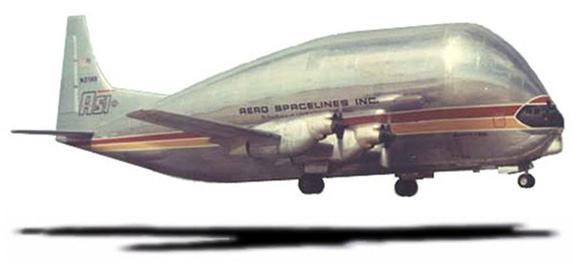
Drawings
 This 3-view drawing shows that although this Super Guppy is very
close in dimensions to the original Super Guppy, the shape of the fuselage
and engine nacelles are completely different. The fuselage has a smoother
flow more remenisent of the Pregnant Guppy.
This 3-view drawing shows that although this Super Guppy is very
close in dimensions to the original Super Guppy, the shape of the fuselage
and engine nacelles are completely different. The fuselage has a smoother
flow more remenisent of the Pregnant Guppy.(60K JPG image)
 A system of rails in the cargo compartment is used with either
Guppy pallets or fixtures designed for specific cargo. Rollers mounted in
the rail allow pallets or fixtures to be moved by an electric winch mounted
beneath the cargo floor. Automatic hydraulic lock pins in the rail secure
the pallet for flight.
A system of rails in the cargo compartment is used with either
Guppy pallets or fixtures designed for specific cargo. Rollers mounted in
the rail allow pallets or fixtures to be moved by an electric winch mounted
beneath the cargo floor. Automatic hydraulic lock pins in the rail secure
the pallet for flight. The Guppy can carry up to three 24 ft. Guppy pallets or sections, making the usable maximum pallet length 72 ft. and a floor load limit of 125 lbs/running inch (cargo rail). The cargo floor is 11 ft. above ground level and 13 ft. wide. The cargo hold has a maximum inside diameter of 25 ft. and overall length of just over 111 ft. with a constant 25 ft. diameter section 32 ft. long. The 377SGT's absolute volume is 49,750 cubic ft. and a usable volume of 39,000 cubic ft. making this the largest of the Guppys.
(25K JPG image)
 When Tracor Aviation (formerly Aero Spacelines, Inc.) was promoting
the new Super Guppy's virtues for transporting outsized cargo, this is one
of the drawings they used. Almost all of the examples used in this artwork
are still in use today. Notice the ease at which the cargo hold of the Guppy
swallows the 15 ft. cargo which in some cases such as the DC-8 or L-100
Super Hercules, is as big around as their fuselages.
When Tracor Aviation (formerly Aero Spacelines, Inc.) was promoting
the new Super Guppy's virtues for transporting outsized cargo, this is one
of the drawings they used. Almost all of the examples used in this artwork
are still in use today. Notice the ease at which the cargo hold of the Guppy
swallows the 15 ft. cargo which in some cases such as the DC-8 or L-100
Super Hercules, is as big around as their fuselages.(27K JPG image)
Pictures
 The first 377SGT Super Guppy Turbine, N211AS (c/n 0001) flew on
August 24, 1970. After success with the first of the 377SGTs, Aero Spacelines
built a second 377SGT, N212AS (c/n 0002) and it flew exactly two years later
on August 24, 1972.
The first 377SGT Super Guppy Turbine, N211AS (c/n 0001) flew on
August 24, 1970. After success with the first of the 377SGTs, Aero Spacelines
built a second 377SGT, N212AS (c/n 0002) and it flew exactly two years later
on August 24, 1972. (22K JPG image)
 ASI originally planned to build and operate the MGT and SGT aircraft
as they had the PG, SG, and MG previously. It was only after the company
got into serious financial trouble that the decision was made to sell the
SGT to Airbus Industrie. This photo shows the first 377SGT with a revised
Aero Spacelines paint scheme taking off from Edward AFB, California for
continued flight testing.
ASI originally planned to build and operate the MGT and SGT aircraft
as they had the PG, SG, and MG previously. It was only after the company
got into serious financial trouble that the decision was made to sell the
SGT to Airbus Industrie. This photo shows the first 377SGT with a revised
Aero Spacelines paint scheme taking off from Edward AFB, California for
continued flight testing.(17K JPG image)
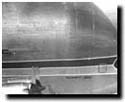

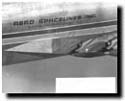
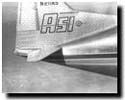
 As a part of the certification, one of the in-flight tests was both side
and forward slips. To see exactly how the air flows over the fuselage and
flying surfaces, tufts are commonly attached. Seen in the first picture,
the air flows smoothly around the nose, with a slight deflection around
the wing, as one would expect. The second and third, and fourth and fifth
pictures show the difference in airflow in both forward flight and a nose
right forward slip. In the last picture of the vertical stabalizer and the
rudder during the slip, notice the amount of distortion on the skin. A moderate
amount of flexing I would say.
As a part of the certification, one of the in-flight tests was both side
and forward slips. To see exactly how the air flows over the fuselage and
flying surfaces, tufts are commonly attached. Seen in the first picture,
the air flows smoothly around the nose, with a slight deflection around
the wing, as one would expect. The second and third, and fourth and fifth
pictures show the difference in airflow in both forward flight and a nose
right forward slip. In the last picture of the vertical stabalizer and the
rudder during the slip, notice the amount of distortion on the skin. A moderate
amount of flexing I would say.(36K, 41K, 36K, 49K & 46K JPG images)
Building the SGT
 Airbus committed to buy one aircraft in 1970 (delivery in 1971)
with a contractural commitment for ASI to build a second SGT that would
be available as back up to the first. In 1973 Airbus optioned to buy No.2.
In 1978 Airbus approached ASI about building a Super Guppys No.3 and 4,
with the agreement being finalized in 1979.
Airbus committed to buy one aircraft in 1970 (delivery in 1971)
with a contractural commitment for ASI to build a second SGT that would
be available as back up to the first. In 1973 Airbus optioned to buy No.2.
In 1978 Airbus approached ASI about building a Super Guppys No.3 and 4,
with the agreement being finalized in 1979.(Click on the thumbnail to go to "Building the SGT")
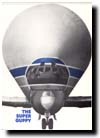
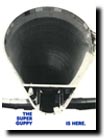
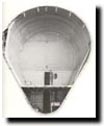
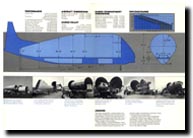

Promotional brochures for the 377SGT (Guppy 201) depicted oversized cargo loads being driven through narrow Europeon city streets causing great disruption of traffic, promoting the use of the Guppys transporting Airbus A300/310 sub-assemblies from various sites in Europe for final assembly in France or Germany. In the last image, note the various factory's locations, and the cargo the Guppy carried to the final assembly plant in Toulouse, France.
(29K, 48K, 37K, 134K & 53K JPG images)
 Aero Spacelines built an entirely new fuselage to connect the
existing C-97 Stratocruiser parts. The only parts taken from the C-97s and
used for this generation of Guppy, were the nose section with presurized
cockpit, wings using the lower section of nacelles, tail surfaces and main
landing gear. The nose wheel is from a Boeing 707, rotated 180 degrees.
A 23 ft. center section was inserted into the wing to give additional clearance
between the tips of the propellers and the fuselage side.
Aero Spacelines built an entirely new fuselage to connect the
existing C-97 Stratocruiser parts. The only parts taken from the C-97s and
used for this generation of Guppy, were the nose section with presurized
cockpit, wings using the lower section of nacelles, tail surfaces and main
landing gear. The nose wheel is from a Boeing 707, rotated 180 degrees.
A 23 ft. center section was inserted into the wing to give additional clearance
between the tips of the propellers and the fuselage side.(19K JPG image)
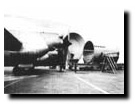 All of the third generation of Guppys (Mini Turbine and Super Turbine)
used the Allison T-56 (501-D22C) Turboprops rated at 4680 ESHP. Aero Spacelines
took the turboprops, cowlings, from the Lockheed Electra/P-3 Orion but used
the propellers and spinners from the C-130 Hercules. The P-3's propellers
are built for speed, whereas the C-130's are built for load carrying. The
upper nacelles were constructed using turboprops from the P-3, with the
upper nacelles adapting the Lockheed cowls to the existing lower nacelles
and landing gear housing. Note in the photo for scale reference, the top
of the door leading to the cockpit is about 5 and a half feet up from the
floor and also note the man standing on the ground. The highest point inside
the fuselage is 25 ft.
All of the third generation of Guppys (Mini Turbine and Super Turbine)
used the Allison T-56 (501-D22C) Turboprops rated at 4680 ESHP. Aero Spacelines
took the turboprops, cowlings, from the Lockheed Electra/P-3 Orion but used
the propellers and spinners from the C-130 Hercules. The P-3's propellers
are built for speed, whereas the C-130's are built for load carrying. The
upper nacelles were constructed using turboprops from the P-3, with the
upper nacelles adapting the Lockheed cowls to the existing lower nacelles
and landing gear housing. Note in the photo for scale reference, the top
of the door leading to the cockpit is about 5 and a half feet up from the
floor and also note the man standing on the ground. The highest point inside
the fuselage is 25 ft. (30K JPG image)
 By comparing the side views of both the Lockheed P-3 Orion and
the 377SGT, it's easy to see the "a little of this and a little of
that" approach Aero Spacelines used in designing the Super Guppy Turbine.
The engineers were smart to adopt this method of design. It ended up being
a great time and money saver. When Aero Spacelines was looking at powerplants
for the new Guppys, they picked the Allison T-56 Turboprop because of it's
relative abundance, and also because Lockheed had already designed a nifty
cowl for the P-3. Why redesign a cowling when an abundant supply already
existed?
By comparing the side views of both the Lockheed P-3 Orion and
the 377SGT, it's easy to see the "a little of this and a little of
that" approach Aero Spacelines used in designing the Super Guppy Turbine.
The engineers were smart to adopt this method of design. It ended up being
a great time and money saver. When Aero Spacelines was looking at powerplants
for the new Guppys, they picked the Allison T-56 Turboprop because of it's
relative abundance, and also because Lockheed had already designed a nifty
cowl for the P-3. Why redesign a cowling when an abundant supply already
existed? (25K JPG image)
 The T56 is the leading turboprop engine in the world, based on
over 17,000 engines sold and more than 150 million accumulated flight hours.
Since their initial production in 1954, the T56/501D engines have been installed
in a wide variety of propeller-powered aircraft. These aerial platforms
include over 2,000 Lockheed C-130 Hercules used by both United States and
foreign military and some 100 plus commercial L-382 (L-100) cargo transport
aircraft. Another Lockheed application is the 600 plus P-3 Orions used in
anti-submarine warfare. Other T56 military platforms include Grumman's E-2
Hawkeye, an early warning aircraft, and the C-2 COD, used for Carrier Onboard
Delivery of supplies and personnel to and from ships.
The T56 is the leading turboprop engine in the world, based on
over 17,000 engines sold and more than 150 million accumulated flight hours.
Since their initial production in 1954, the T56/501D engines have been installed
in a wide variety of propeller-powered aircraft. These aerial platforms
include over 2,000 Lockheed C-130 Hercules used by both United States and
foreign military and some 100 plus commercial L-382 (L-100) cargo transport
aircraft. Another Lockheed application is the 600 plus P-3 Orions used in
anti-submarine warfare. Other T56 military platforms include Grumman's E-2
Hawkeye, an early warning aircraft, and the C-2 COD, used for Carrier Onboard
Delivery of supplies and personnel to and from ships.(21K JPG image)
 The loading system for the 377SGT was as unique as the airplane.
Airbus fuselage and wing sections are strapped to custom loading dollys,
which are loaded onto a custom driveable sissoring jack. The load is driven
up to the opened nose of the aircraft, pushed on rollers into place inside
the airplane.
The loading system for the 377SGT was as unique as the airplane.
Airbus fuselage and wing sections are strapped to custom loading dollys,
which are loaded onto a custom driveable sissoring jack. The load is driven
up to the opened nose of the aircraft, pushed on rollers into place inside
the airplane. (25K JPG image)

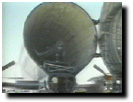 The difference between the two Super Guppys is apparent when comparing these
two photos. By constructing a new fuselage, Aero Spacelines was able to
increase the width of the floor from 8 ft. on the NASA Super Guppy to 13
ft. for the Super Guppy Turbine. The aluminium skin over bulkhead and stringer
method of construction for all Guppys can be seen in the photo of the NASA
Guppy. But for Type Certification, the FAA didn't like the way the bare
inside of the fuselage looked, so they made Aero Spacelines add a Nomex
lining to the inside of the cargo hold.
The difference between the two Super Guppys is apparent when comparing these
two photos. By constructing a new fuselage, Aero Spacelines was able to
increase the width of the floor from 8 ft. on the NASA Super Guppy to 13
ft. for the Super Guppy Turbine. The aluminium skin over bulkhead and stringer
method of construction for all Guppys can be seen in the photo of the NASA
Guppy. But for Type Certification, the FAA didn't like the way the bare
inside of the fuselage looked, so they made Aero Spacelines add a Nomex
lining to the inside of the cargo hold.(49K & 29K JPG images)
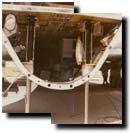
 The nose locking was also refined with a hydraulic locking pin
mechanism replacing the earlier bolting method. Like all Guppys, the 377SGT
was equipted with 3 jacks in the fuselage; two in front of the wing as seen
in the composite photo on the left and one behind the wing as shown in the
picture on the right (note the steel plate used to spread the load of the
rear jack). These jacks were deployed to support and steady the airplane
before the joint could be unlocked and the nose opened and wheeled out of
the way.
The nose locking was also refined with a hydraulic locking pin
mechanism replacing the earlier bolting method. Like all Guppys, the 377SGT
was equipted with 3 jacks in the fuselage; two in front of the wing as seen
in the composite photo on the left and one behind the wing as shown in the
picture on the right (note the steel plate used to spread the load of the
rear jack). These jacks were deployed to support and steady the airplane
before the joint could be unlocked and the nose opened and wheeled out of
the way.(33K & 18K JPG images)
 The first 377SGT was sold to Airbus Industrie in 1971. The second
was sold in 1973. The sub-assemblies for the third and fourth 377SGT were
delivered in 1978 and 1979 respectively, number 3 flew in 1979 and number
4 in 1980. The four Super Guppys became a vital part of the production process
for Airbus Industrie, operating a regularly scheduled route five days a
week.
The first 377SGT was sold to Airbus Industrie in 1971. The second
was sold in 1973. The sub-assemblies for the third and fourth 377SGT were
delivered in 1978 and 1979 respectively, number 3 flew in 1979 and number
4 in 1980. The four Super Guppys became a vital part of the production process
for Airbus Industrie, operating a regularly scheduled route five days a
week.(29K JPG image)
 Compare
the length of the Airbus fuselage section to the length of the Super Guppy's
hold as it swallows the Airbus. With the low angle and the distance the
photographer is from the Guppy, it looks almost as if it could be a model.
Note the size of the yellow Volkwagen van in front of the loading dolly,
and imagine how many of those vans would fit inside of the Guppy's hold.
Compare
the length of the Airbus fuselage section to the length of the Super Guppy's
hold as it swallows the Airbus. With the low angle and the distance the
photographer is from the Guppy, it looks almost as if it could be a model.
Note the size of the yellow Volkwagen van in front of the loading dolly,
and imagine how many of those vans would fit inside of the Guppy's hold.(43K JPG image)
 Operating a fleet of Super Guppys is not without incident. Loading
operations are rated up to a 20 knots crosswind. Airbus Industrie found
out the hard way a couple of times to follow published operating procedures
when a gust of wind caught the opened nose of a Super Guppy, causing it
to act like a giant sail, tearing itself loose from the fuselage. This happened
once in Madrid and again in Hamburg.
Operating a fleet of Super Guppys is not without incident. Loading
operations are rated up to a 20 knots crosswind. Airbus Industrie found
out the hard way a couple of times to follow published operating procedures
when a gust of wind caught the opened nose of a Super Guppy, causing it
to act like a giant sail, tearing itself loose from the fuselage. This happened
once in Madrid and again in Hamburg.(28K JPG image)

 Another incident happened early in SGT No.1's career with Airbus in which
the SGT ran off the runway. The nosegear, unable to hold up to the rough
soft terrain, collapsed. When this happened a crewmember was ejected from
the auxilary jumpseat and was seriously injured. The restraint harnesses
were redesigned to prevent this type of accident in the future.
Another incident happened early in SGT No.1's career with Airbus in which
the SGT ran off the runway. The nosegear, unable to hold up to the rough
soft terrain, collapsed. When this happened a crewmember was ejected from
the auxilary jumpseat and was seriously injured. The restraint harnesses
were redesigned to prevent this type of accident in the future.(31K & 19K JPG images)

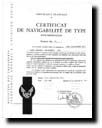
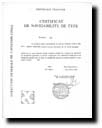 The Type Certificate for the 377MG Mini-Guppy and the 377SGT Super Guppy
Turbine was originally issued to Aero Spacelines. Aero Spacelines was then
sold to Tracor, Inc. and renamed Tracor Aviation in 1981, who picked up
the maintance contracts for the Guppys. Tracor also developed the hush kits
for the then Douglas DC-8s and Boeing 707s. Tracor no longer built aircraft
but went into the airframe modification business, installing cargo doors
on aircraft, and maintaining various commercial jets including McDonnell-Douglas
DC-10s, Boeing 747s and smaller business jets.
The Type Certificate for the 377MG Mini-Guppy and the 377SGT Super Guppy
Turbine was originally issued to Aero Spacelines. Aero Spacelines was then
sold to Tracor, Inc. and renamed Tracor Aviation in 1981, who picked up
the maintance contracts for the Guppys. Tracor also developed the hush kits
for the then Douglas DC-8s and Boeing 707s. Tracor no longer built aircraft
but went into the airframe modification business, installing cargo doors
on aircraft, and maintaining various commercial jets including McDonnell-Douglas
DC-10s, Boeing 747s and smaller business jets.  Tracor Aviation was then sold to Lucas Aerospace and renamed Lucas
Aviation. Lucas Aviation continued technical support for the Guppys until
the late 1990s, when Airbus Industrie unveiled the replacement for aging
fleet of Super Guppys, the A300-600ST Beluga. A "Super" Super
Guppy, based on the A310 Airbus airframe. Seen in this picture is SGT No.2
with the special graphics commemerating Tracor's 25th anniversary.
Tracor Aviation was then sold to Lucas Aerospace and renamed Lucas
Aviation. Lucas Aviation continued technical support for the Guppys until
the late 1990s, when Airbus Industrie unveiled the replacement for aging
fleet of Super Guppys, the A300-600ST Beluga. A "Super" Super
Guppy, based on the A310 Airbus airframe. Seen in this picture is SGT No.2
with the special graphics commemerating Tracor's 25th anniversary.(20K JPG image)
 As
this nose to nose comparison shows, although the A300-600ST is longer, and
carries more weight, the Super Guppy is still a sizable airplane in anybody's
book. The 377SGTs are not being retired because they've out-lived their
usefulness, on the contrary, they're being retired because of age and high
service hours.
As
this nose to nose comparison shows, although the A300-600ST is longer, and
carries more weight, the Super Guppy is still a sizable airplane in anybody's
book. The 377SGTs are not being retired because they've out-lived their
usefulness, on the contrary, they're being retired because of age and high
service hours.(14K JPG image)
 Super Guppy No.1 was retired to the British Aviation Heritage
in Bruntingthorpe, England in 1996. No.2 is preserved at Airbus Industrie's
final assembly plant in Toulouse, France also in 1996. No.3 as of November,
1997 is on diplay at the Airbus assembly plant in Finkenwerder, near Hamburg,
Germany.
Super Guppy No.1 was retired to the British Aviation Heritage
in Bruntingthorpe, England in 1996. No.2 is preserved at Airbus Industrie's
final assembly plant in Toulouse, France also in 1996. No.3 as of November,
1997 is on diplay at the Airbus assembly plant in Finkenwerder, near Hamburg,
Germany.(16K JPG image)
SGT No. 1
 In this picture, Super Guppy No.1 is seen at it's final home at
the British Aviation Heritage in Bruntingthorpe, England. SGT No.1 is currently
undergoing restoration as time and money permits. The engines have been
permanently removed. Notice the propellers lying in the grass below the
wings waiting to re-mounted to the cowlings.
In this picture, Super Guppy No.1 is seen at it's final home at
the British Aviation Heritage in Bruntingthorpe, England. SGT No.1 is currently
undergoing restoration as time and money permits. The engines have been
permanently removed. Notice the propellers lying in the grass below the
wings waiting to re-mounted to the cowlings.(23K JPG image)
 SGT No.1 is seen in this picture taken March 1998 with it's propellers
reattached and looking much more dignified. While the Guppy isn't yet open
to the public, the airfield is open every Sunday from 10 am to 4 pm. There
are plans to turn the SGT into a museum and house smaller exibits inside,
but it's not clear at this time if this will ever come to fruitation.
SGT No.1 is seen in this picture taken March 1998 with it's propellers
reattached and looking much more dignified. While the Guppy isn't yet open
to the public, the airfield is open every Sunday from 10 am to 4 pm. There
are plans to turn the SGT into a museum and house smaller exibits inside,
but it's not clear at this time if this will ever come to fruitation. (33K JPG image)
SGT No. 2
 Super Guppy No.2 is seen here on display at the Airbus final assembly
plant in Toulouse, France. No.2 is now owned and cared for by Ailes Anciennes
Toulouse (Toulouse old wings), a not for profit group of aviation enthusists
in France. Ailes Anciennes Toulouse has been perserving historical aircraft
for 15 years. Although they have many aircraft in their collection, they
haven't been able to secure a building to house all of these wonderful bits
of aviation history. Notice that Airbus kept the "Super Guppy" portion of
the earlier Tracor Aviation 25th Anniversary special paint job.
Super Guppy No.2 is seen here on display at the Airbus final assembly
plant in Toulouse, France. No.2 is now owned and cared for by Ailes Anciennes
Toulouse (Toulouse old wings), a not for profit group of aviation enthusists
in France. Ailes Anciennes Toulouse has been perserving historical aircraft
for 15 years. Although they have many aircraft in their collection, they
haven't been able to secure a building to house all of these wonderful bits
of aviation history. Notice that Airbus kept the "Super Guppy" portion of
the earlier Tracor Aviation 25th Anniversary special paint job. (28K JPG image)
 This picture of No.2 was taken at the "Bikini"
engine test area in Toulouse, France. After Airbus decided to keep one of
each of the Super Guppys in each of the main Airbus countries, the museum
in Bourget was first offered No.2, which they declined. Possibly because
of space considerations.
This picture of No.2 was taken at the "Bikini"
engine test area in Toulouse, France. After Airbus decided to keep one of
each of the Super Guppys in each of the main Airbus countries, the museum
in Bourget was first offered No.2, which they declined. Possibly because
of space considerations. One of Ailes Anciennes Toulouse's members was the Chief Engineer for SGT spare parts. This gentleman was able to secure No.2 for Ailes Anciennes Toulouse. When Airbus retired the Guppys, they sold all of the Allison turboprops and spare parts used to support the Guppys. This Guppy like the other three that Airbus retired, has had the engines removed and the propellers remounted for static display. A Guppy without propellers isn't nice.
(24K JPG image)
SGT No. 3


 This article appeared in the December 24, 1997-January 6, 1998 issue of
Flight International. Author Allan Winn went along on Super Guppy No.3's
last flight to Finkenwerder, Germany. He wrote a fitting tribute to the
aircraft that did so much for Airbus Industrie. Be warned, these images
are kind of big, but well worth the reading. Enjoy!
This article appeared in the December 24, 1997-January 6, 1998 issue of
Flight International. Author Allan Winn went along on Super Guppy No.3's
last flight to Finkenwerder, Germany. He wrote a fitting tribute to the
aircraft that did so much for Airbus Industrie. Be warned, these images
are kind of big, but well worth the reading. Enjoy! (106K, 116K, 115K JPG images)
 Over the December 14, 1997 weekend Super Guppy No.3 received a
new paint job in preparation for long-term outdoor display. All polished
aluminium surfaces are now painted silver for better weather protection.
Without the paint the skin would have to be polished about once a year.
The stripes and lettering have also been repainted and are generally the
same as before.
Over the December 14, 1997 weekend Super Guppy No.3 received a
new paint job in preparation for long-term outdoor display. All polished
aluminium surfaces are now painted silver for better weather protection.
Without the paint the skin would have to be polished about once a year.
The stripes and lettering have also been repainted and are generally the
same as before.(33K JPG image)
 On the weekend of December 21, 1997 SGT No.3 was moved to it's
final destination proudly parked in front of the main entrance of the DASA
factory in Finkenwerder, Germany. Getting Super Guppy into place required
the permanant removal of two trees and the temporary removal of about 8
street lights. Also on display is a HFB 320 Hansa Jet and a Noratlas transport,
seen here.
On the weekend of December 21, 1997 SGT No.3 was moved to it's
final destination proudly parked in front of the main entrance of the DASA
factory in Finkenwerder, Germany. Getting Super Guppy into place required
the permanant removal of two trees and the temporary removal of about 8
street lights. Also on display is a HFB 320 Hansa Jet and a Noratlas transport,
seen here. (32K JPG image)
SGT No. 4
 On October 23, 1997 SGT No.4, now registered as N941NA, landed
at Ellington Field, Houston, Texas to a hero's welcome. 941 as the Super
Guppy is called in order to ease confusion over which of NASA's Super Guppys
one is referring to, will be based out of Johnson Space Center. 941's mission
is to ferry outsize components from around the globe back to the United
States in preparation for launch into orbit.
On October 23, 1997 SGT No.4, now registered as N941NA, landed
at Ellington Field, Houston, Texas to a hero's welcome. 941 as the Super
Guppy is called in order to ease confusion over which of NASA's Super Guppys
one is referring to, will be based out of Johnson Space Center. 941's mission
is to ferry outsize components from around the globe back to the United
States in preparation for launch into orbit.The day after landing in Houston, the Guppy was out for crew familiarization. The 941 crew put the youngest of the Super Guppys through it's paces shooting approx. six touch and goes. During one flight a T-38 gave chase for an in-flight photo session. All reference to 941's Airbus past has been removed, with the exception of the number 4 on the fuselage above the cockpit. Also seen in this picture is NASA's high-altitude research vehicle, the Martin RB-57 with it's lengthened outer wing panels.
(21K JPG image)
Inside 941
 In keeping with past tradition, NASA has again looked to the
Super Guppy to help insure the success of one of it's biggest projects to
date; the International Space Station. Super Guppy No.4 was acquired by
NASA from the European Space Agency under an International Space Station
barter agreement. ESA supplied the Guppy to offset the cost to NASA of carrying
ESA experiment equipment to the station as part of two future Space Shuttle
flights. NASA's newest Guppy crew spent four weeks in France getting checked
out on the Super Guppy.
In keeping with past tradition, NASA has again looked to the
Super Guppy to help insure the success of one of it's biggest projects to
date; the International Space Station. Super Guppy No.4 was acquired by
NASA from the European Space Agency under an International Space Station
barter agreement. ESA supplied the Guppy to offset the cost to NASA of carrying
ESA experiment equipment to the station as part of two future Space Shuttle
flights. NASA's newest Guppy crew spent four weeks in France getting checked
out on the Super Guppy. (Click on the thumbnail to look "Inside 941")
 The de-icer system for the outer wing sections consists of a fuel
heater in the rear of the outer engine nacelles. The inner de-icers use
engine bleed air for heat. The 377SGT uses constant speed engines which
run at 98-103% power ratings. Airspeed is around 200 kts at low altitudes.
At higher altitudes 941 is limited to Mach 185 KIAS. Of note, the rudder
and elevator surfaces are fabric covered, a technology from a bygone era.
The rudder has been replaced or at least re-covered at some time during
941's life.
The de-icer system for the outer wing sections consists of a fuel
heater in the rear of the outer engine nacelles. The inner de-icers use
engine bleed air for heat. The 377SGT uses constant speed engines which
run at 98-103% power ratings. Airspeed is around 200 kts at low altitudes.
At higher altitudes 941 is limited to Mach 185 KIAS. Of note, the rudder
and elevator surfaces are fabric covered, a technology from a bygone era.
The rudder has been replaced or at least re-covered at some time during
941's life.(65K JPG image)
 One feature that suprised many connected with 941 was the method
of construction used on the fuselage, similar to the Mini Guppy seen in
this picture taken during 377MG's construction in Santa Barbara, California.
The fuselage sheeting was overlapped, shingle fashion with standard or round
head rivets used to attach the sheets to the bulkheads and stringers. The
C-97 cockpit section and P-3 cowls still retain the flush rivets originally
used. Some of the rivets have been replaced with hex head bolts at some
point, though it's not clear by whom or why.
One feature that suprised many connected with 941 was the method
of construction used on the fuselage, similar to the Mini Guppy seen in
this picture taken during 377MG's construction in Santa Barbara, California.
The fuselage sheeting was overlapped, shingle fashion with standard or round
head rivets used to attach the sheets to the bulkheads and stringers. The
C-97 cockpit section and P-3 cowls still retain the flush rivets originally
used. Some of the rivets have been replaced with hex head bolts at some
point, though it's not clear by whom or why.(47K JPG image)
 Some of the senior Johnson Space Center engineers who helped launch
Apollo remember the original Super Guppy. Some of the improvements include
a pressurized cockpit with seating for three crew and four passengers, a
better air-conditioner that works down to and on the ground instead of the
original's limitation of not working below 5000 ft. The 377SG's all manual
fuselage latches were replaced with upper hydraulic latches on the 377SGTs.
941's cockpit layout has been improved and has a better radio system. JSC
engineers are seen here inspecting the drive wheel for the swing nose.
Some of the senior Johnson Space Center engineers who helped launch
Apollo remember the original Super Guppy. Some of the improvements include
a pressurized cockpit with seating for three crew and four passengers, a
better air-conditioner that works down to and on the ground instead of the
original's limitation of not working below 5000 ft. The 377SG's all manual
fuselage latches were replaced with upper hydraulic latches on the 377SGTs.
941's cockpit layout has been improved and has a better radio system. JSC
engineers are seen here inspecting the drive wheel for the swing nose. (51K JPG image)

 One final note about 941 not mentioned on this page about a part, or should
I say a section of the aircraft's history. It is the 46 section of the fuselage
- the aft lower part of the fuselage. In building Guppy No. 4 for Airbus
Industrie, ASI found that there were no remaining B377 fuselages to cannibalize,
so ASI bought the 46 section from the disassembled Pregnant Guppy and shipped
it to France where it was incorporated into SGT No.4. Seen in these pictures,
the section has been placed in a custom jig for a partial reskining, also
note in the left picture, the workman inside the 46 section.
One final note about 941 not mentioned on this page about a part, or should
I say a section of the aircraft's history. It is the 46 section of the fuselage
- the aft lower part of the fuselage. In building Guppy No. 4 for Airbus
Industrie, ASI found that there were no remaining B377 fuselages to cannibalize,
so ASI bought the 46 section from the disassembled Pregnant Guppy and shipped
it to France where it was incorporated into SGT No.4. Seen in these pictures,
the section has been placed in a custom jig for a partial reskining, also
note in the left picture, the workman inside the 46 section.(41K & 33K JPG images)

 Seen in the picture on the left is actually the 45 and 46 sections
still joined before being prepared for shipping to Airbus. The 46 section
is the part of the fuselage that incorporates the mount for the horizontal
tail surfaces as pictured in the right photo. How ironic that the last Guppy
built contains a part of the first Guppy built using one of the first Stratocruisers
built.
Seen in the picture on the left is actually the 45 and 46 sections
still joined before being prepared for shipping to Airbus. The 46 section
is the part of the fuselage that incorporates the mount for the horizontal
tail surfaces as pictured in the right photo. How ironic that the last Guppy
built contains a part of the first Guppy built using one of the first Stratocruisers
built.(51K & 34K JPG images)
New Look for 941!
 NASA Super Guppy N941NA is sporting a shiny new look to carry her crew into
the next millenium! In early in December Leading Edge, a commercial aircraft
painter at the old Eaker AFB at Blytheville, Arkansas tackled the challenging
job of polishing and repainting NASA's Super Guppy! Thanks to Dave Shank,
we're able to bring you this first look including the first take-off and
in flight photos.
NASA Super Guppy N941NA is sporting a shiny new look to carry her crew into
the next millenium! In early in December Leading Edge, a commercial aircraft
painter at the old Eaker AFB at Blytheville, Arkansas tackled the challenging
job of polishing and repainting NASA's Super Guppy! Thanks to Dave Shank,
we're able to bring you this first look including the first take-off and
in flight photos.(Click on the thumbnail to see the "New Look for 941!")
The Crew of 941
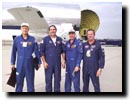 We have added this new page to give everyone an opportunity to
meet the guys who fly and maintain NASA's Super Guppy. This page will be
updated as different crew members come out, and are willing to have their
pictures taken.
We have added this new page to give everyone an opportunity to
meet the guys who fly and maintain NASA's Super Guppy. This page will be
updated as different crew members come out, and are willing to have their
pictures taken.(Click on the thumbnail to "Meet the crew of 941")
The Loadmasters of 941
 The
Loadmasters of N941NA are responsible for the correct loading of the Super
Guppy and that the cargo arrives safely at it's destinations. Pictured above
are the seven Loadmasters assigned to the Super Guppy in support of the
International Space Station. They are employees of Airlift Technologies
International Inc., which is on contract to NASA.
The
Loadmasters of N941NA are responsible for the correct loading of the Super
Guppy and that the cargo arrives safely at it's destinations. Pictured above
are the seven Loadmasters assigned to the Super Guppy in support of the
International Space Station. They are employees of Airlift Technologies
International Inc., which is on contract to NASA.(Click on the thumbnail to "Meet the Loadmasters of 941")
International Space Station
 We will be posting International Space Station related items
on this page. Take a look at the Orange County Register's coverage of 941's
last couple of trips to Southern California. The most recent article was
published June 9, 1999.
We will be posting International Space Station related items
on this page. Take a look at the Orange County Register's coverage of 941's
last couple of trips to Southern California. The most recent article was
published June 9, 1999. (Click on the thumbnail to learn more about the "International Space Station")
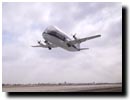 N941 is seen here just after take off on Thursday June 10, 1999
from Los Alamitos Army Airfield carrying the S-0. This is commonly referred
to as the heart of the International Space Station. The crew is taking the
S-0 to Kennedy Space Center in Florida for testing.
N941 is seen here just after take off on Thursday June 10, 1999
from Los Alamitos Army Airfield carrying the S-0. This is commonly referred
to as the heart of the International Space Station. The crew is taking the
S-0 to Kennedy Space Center in Florida for testing.(25K JPG image)



 NASA's
Super Guppy makes the cover of the Ocotber, 2000 issue of FLYING
magazine! N941 was one of the star attractions at the 2000 EAA AirVenture
Oshkosh at Wittman Regional Airport in Oshkosh, Wisconsin, July 26 - August
1. In the last image, the Guppy is seen on the tarmac.
NASA's
Super Guppy makes the cover of the Ocotber, 2000 issue of FLYING
magazine! N941 was one of the star attractions at the 2000 EAA AirVenture
Oshkosh at Wittman Regional Airport in Oshkosh, Wisconsin, July 26 - August
1. In the last image, the Guppy is seen on the tarmac.(63K, 73K, 65K & 15K JPG images) Click here go to FLYING magazine's website
2003 Dayton Airshow
 Thanks guys! We're not sure what the story is on this one, but we've been
assure new photos are forthcoming. We will post them once we get them.
Thanks guys! We're not sure what the story is on this one, but we've been
assure new photos are forthcoming. We will post them once we get them.(78K JPG image)
Movies
QuickTimeVRs
 Take a look inside the Super Guppy! The QuickTimeVR on the left is a 360
degree panorama which was created from pictures taken on October 28, 1998
from the cargo deck of the Super Guppy during NASA's loading operation of
the second test article for the International Space Station Project at Los
Alamitos Army Airfield, California. Among the interesting things to see
in the background are the cranes used to load the cargo onto the loading
dolley; a couple of "Medfly Bombers", so called because of their mission
dropping frozen Medflies throughout California and a C-123 Provider.
Take a look inside the Super Guppy! The QuickTimeVR on the left is a 360
degree panorama which was created from pictures taken on October 28, 1998
from the cargo deck of the Super Guppy during NASA's loading operation of
the second test article for the International Space Station Project at Los
Alamitos Army Airfield, California. Among the interesting things to see
in the background are the cranes used to load the cargo onto the loading
dolley; a couple of "Medfly Bombers", so called because of their mission
dropping frozen Medflies throughout California and a C-123 Provider.(849K QuickTimeVR Panorama)
 Then take a walk around the Super Guppy and see the her new paint scheme!
These pictures were taken on 941's first trip to Los Alamitos Army Airfield,
California after the NASA crew picked up the Guppy from Leading Edge in
Blytheville, Arkansas. We met up with the crew when they arrived at Los
Al on Friday January 22 and took the pictures used to create this VR movie
the next day. As always, the guys on the crew were very helpful and accommodating.
Then take a walk around the Super Guppy and see the her new paint scheme!
These pictures were taken on 941's first trip to Los Alamitos Army Airfield,
California after the NASA crew picked up the Guppy from Leading Edge in
Blytheville, Arkansas. We met up with the crew when they arrived at Los
Al on Friday January 22 and took the pictures used to create this VR movie
the next day. As always, the guys on the crew were very helpful and accommodating.
(277K QuickTimeVR SpinObject)
We would like extend a special note of appreciation to the crew of 941 for allowing us the opportunity to take these images we're sharing with you. Thanks guys!
You will need the QuickTime and QuickTimeVR plug-ins to view these movies. Users of Netscape 3.0 or later have the QuickTime plug-in built in to their browsers, but you will still need to get the QTVR plug-in. Get the plug-in for QuickTimeVR by linking here.
Once the Movie is loaded, use your mouse to click and drag either left or right. For the Panorama, use your "Shift" and "Control" keys to zoom in and out also, but not necessarily at the same time. If after loading the Panorama you only see a playbar, you don't have the correct VR plug-in loaded. Go to the above link to Apple and get a copy of QuickTime3 and install it. Then the Movie should play okay.
 In this YouTube of the Orange County News (OCN), coverage of the
Super Guppy arrival at Los Alamitos Army Airfield bringing an International
Space Station component to Boeing in Huntington Beach, California. In this
news spot the Guppy is seen sporting a new paint job. Especially interesting
is the smooth nose wheel first landing, nose opening and unloading operations.
In this YouTube of the Orange County News (OCN), coverage of the
Super Guppy arrival at Los Alamitos Army Airfield bringing an International
Space Station component to Boeing in Huntington Beach, California. In this
news spot the Guppy is seen sporting a new paint job. Especially interesting
is the smooth nose wheel first landing, nose opening and unloading operations.
 Listen to this streaming RealAudio
interview with NASA pilots Frank Marlow and Triple Nickel as they talk
about flying the Super Guppy, courtesy of the Orange County Register.
Listen to this streaming RealAudio
interview with NASA pilots Frank Marlow and Triple Nickel as they talk
about flying the Super Guppy, courtesy of the Orange County Register.
To enjoy either of these streaming media, you will need to install RealPlayer.
To get a free copy of RealPlayer
here.
Videos
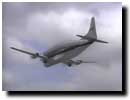 This video was shot on June 10, 1999 at Los Alamitos Army Airfield showing
NASA 941 during take off with the S-0. The S-0 is the 44 foot center section
of the International Space Station's 356 foot frame or truss.
This video was shot on June 10, 1999 at Los Alamitos Army Airfield showing
NASA 941 during take off with the S-0. The S-0 is the 44 foot center section
of the International Space Station's 356 foot frame or truss. 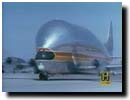 In this video we see the prototype 377SGT (Guppy 201) N211AS undergoing
flight testing at Edwards AFB, California. The success of Aero Spacelines
and it's Guppys attracted the attention of other firms. In July 1965 Aero
Spacelines was acquired by Unexcelled Chemical Corporation with Aero Spacelines
still operating as an independant subsidiary. The new organization not only
intended to continue the Super Guppy line of aircraft, it announced it's
intention to build a small fleet of outsize transports.
In this video we see the prototype 377SGT (Guppy 201) N211AS undergoing
flight testing at Edwards AFB, California. The success of Aero Spacelines
and it's Guppys attracted the attention of other firms. In July 1965 Aero
Spacelines was acquired by Unexcelled Chemical Corporation with Aero Spacelines
still operating as an independant subsidiary. The new organization not only
intended to continue the Super Guppy line of aircraft, it announced it's
intention to build a small fleet of outsize transports. The British Aviation Heritage in Bruntingthorpe, England is the final home for Super Guppy No.1. It was retired in 1996 when the first of the A300-600ST Belugas became available to replace the valued but aging Guppys.
 Note
in this video clip the skill of the pilot landing the airplane, there must
be a stiff cross wind judging from the amount of side-slip needed to hold
the airplane on course. But considering the generous side area of these
aircraft, it wouldn't take too high of a crosswind to be a handfull.
Note
in this video clip the skill of the pilot landing the airplane, there must
be a stiff cross wind judging from the amount of side-slip needed to hold
the airplane on course. But considering the generous side area of these
aircraft, it wouldn't take too high of a crosswind to be a handfull. Comments or Questions? Email me
Copyright © 2006 Daren Savage
All Rights Reserved